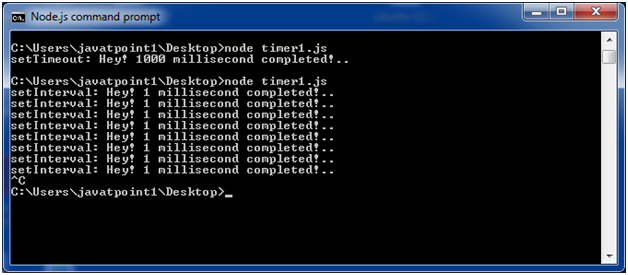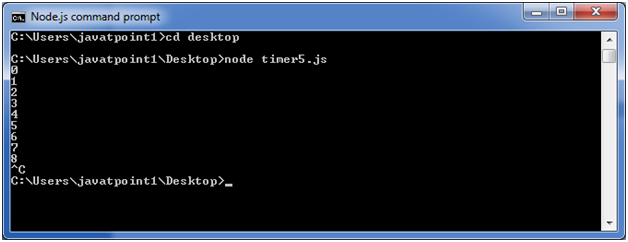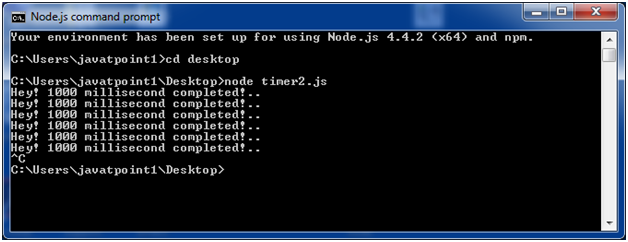📌 相关文章
- Node.js 计时器完整参考(1)
- Node.js 计时器完整参考
- 计时器 - Python (1)
- Python中的计时器
- Python中的计时器(1)
- python中的计时器(1)
- JavaScript计时器(1)
- JavaScript计时器
- 计时器 - Javascript (1)
- javascript中的计时器(1)
- 计时器 - Python 代码示例
- python代码示例中的计时器
- javascript代码示例中的计时器
- 计时器 - Javascript 代码示例
- Node.js流
- Node.js-流
- Node.js流(1)
- Node.js 流
- Node.js 流(1)
- Node.js-流(1)
- 设置计时器 - Javascript (1)
- D3.js-计时器API
- D3.js-计时器API(1)
- 设置计时器 - Javascript 代码示例
- Swift中的计时器
- Swift中的计时器(1)
- 如何在javascript中设置计时器(1)
- 如何在 Next.js 中添加计时器?
- 如何在 Next.js 中添加计时器?(1)
📜 Node.js计时器
📅 最后修改于: 2020-12-24 03:33:02 🧑 作者: Mango
Node.js计时器
Node.js Timer函数是全局函数。您无需使用require()函数即可使用计时器函数。让我们看看计时器功能列表。
设置计时器功能:
- setImmediate():用于执行setImmediate。
- setInterval():用于定义时间间隔。
- setTimeout(): ()-用于延迟毫秒后执行一次回调。
清除计时器功能:
- clearImmediate(immediateObject):用于停止由setImmediate创建的即时对象。
- clearInterval(intervalObject):用于停止由setInterval创建的intervalObject
- clearTimeout(timeoutObject):防止由setTimeout创建的timeoutObject
Node.js计时器setInterval()示例
本示例将时间间隔设置为1000毫秒,并且每隔1000毫秒将显示指定的注释,直到您终止。
文件:timer1.js
setInterval(function() {
console.log("setInterval: Hey! 1 millisecond completed!..");
}, 1000);
打开Node.js命令提示符并运行以下代码:
node timer1.js

文件:timer5.js
var i =0;
console.log(i);
setInterval(function(){
i++;
console.log(i);
}, 1000);
打开Node.js命令提示符并运行以下代码:
node timer5.js

Node.js计时器setTimeout()示例
文件:timer1.js
setTimeout(function() {
console.log("setTimeout: Hey! 1000 millisecond completed!..");
}, 1000);
打开Node.js命令提示符并运行以下代码:
node timer1.js

本示例显示每隔1000毫秒超时,但未设置时间间隔。本示例使用函数的递归属性。
文件:timer2.js
var recursive = function () {
console.log("Hey! 1000 millisecond completed!..");
setTimeout(recursive,1000);
}
recursive();
打开Node.js命令提示符并运行以下代码:
node timer2.js

Node.js setInterval(),setTimeout()和clearTimeout()
让我们看一个使用clearTimeout()函数的示例。
文件:timer3.js
function welcome () {
console.log("Welcome to JavaTpoint!");
}
var id1 = setTimeout(welcome,1000);
var id2 = setInterval(welcome,1000);
clearTimeout(id1);
//clearInterval(id2);
打开Node.js命令提示符并运行以下代码:
node timer3.js

您可以看到上面的示例本质上是递归的。如果使用ClearInterval,它将在一步之后终止。
Node.js setInterval(),setTimeout()和clearInterval()
让我们看一个使用clearInterval()函数的示例。
文件:timer3.js
function welcome () {
console.log("Welcome to JavaTpoint!");
}
var id1 = setTimeout(welcome,1000);
var id2 = setInterval(welcome,1000);
//clearTimeout(id1);
clearInterval(id2);
打开Node.js命令提示符并运行以下代码:
node timer3.js
